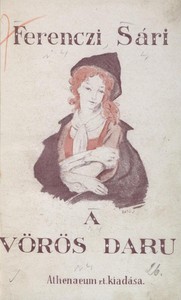A vörös daru by Sári Ferenczi
"A vörös daru" by Sári Ferenczi is a historical novel written in the early 20th century. The narrative centers around the character of Emperor Francis, who returns to Buda amid the anticipation of peace following the Napoleonic Wars. The story explores themes of desire, human connection, and political intrigue, weaving in elements of folklore through the symbolism of the red crane, which plays a significant role in reflecting the characters' aspirations and
emotions. At the start of the novel, we see the excitement that greets Emperor Francis upon his arrival in Buda, where citizens long for stability after years of war. The emperor, feeling the weight of his role, engages with his subjects, but also expresses a whimsical curiosity about a crane, delving into discussions about this bird with his confidants. Simultaneously, we are introduced to the enchanting figure of Franciska, the daughter of a talented clockmaker, whose charm captivates a young nobleman, Hardenegg. As the initial chapter unfolds, the interwoven lives of the characters—along with hints of romantic interests and political duties—set the stage for a richly detailed exploration of society during a tumultuous era. (This is an automatically generated summary.)
Read or download for free
| How to read | Url | Size | |||
|---|---|---|---|---|---|
| Read now! | https://www.gutenberg.org/ebooks/72580.html.images | 540 kB | |||
| EPUB3 (E-readers incl. Send-to-Kindle) | https://www.gutenberg.org/ebooks/72580.epub3.images | 356 kB | |||
| EPUB (older E-readers) | https://www.gutenberg.org/ebooks/72580.epub.images | 353 kB | |||
| EPUB (no images, older E-readers) | https://www.gutenberg.org/ebooks/72580.epub.noimages | 302 kB | |||
| Kindle | https://www.gutenberg.org/ebooks/72580.kf8.images | 513 kB | |||
| older Kindles | https://www.gutenberg.org/ebooks/72580.kindle.images | 472 kB | |||
| Plain Text UTF-8 | https://www.gutenberg.org/ebooks/72580.txt.utf-8 | 503 kB | |||
| Download HTML (zip) | https://www.gutenberg.org/cache/epub/72580/pg72580-h.zip | 301 kB | |||
| There may be more files related to this item. | |||||
Similar Books
About this eBook
| Author | Ferenczi, Sári, 1887-1952 |
|---|---|
| Title | A vörös daru |
| Original Publication | Budapest: Athenaeum, 1919. |
| Credits | Albert László from page images generously made available by the Hungarian Electronic Library |
| Reading Level | Reading ease score: 65.3 (8th & 9th grade). Neither easy nor difficult to read. |
| Language | Hungarian |
| LoC Class | PH: Language and Literatures: Finno-Ugrian and Basque languages and literatures |
| Subject | Historical fiction |
| Subject | Congress of Vienna (1814-1815) -- Fiction |
| Category | Text |
| EBook-No. | 72580 |
| Release Date | Jan 1, 2024 |
| Copyright Status | Public domain in the USA. |
| Downloads | 222 downloads in the last 30 days. |
| Project Gutenberg eBooks are always free! | |

